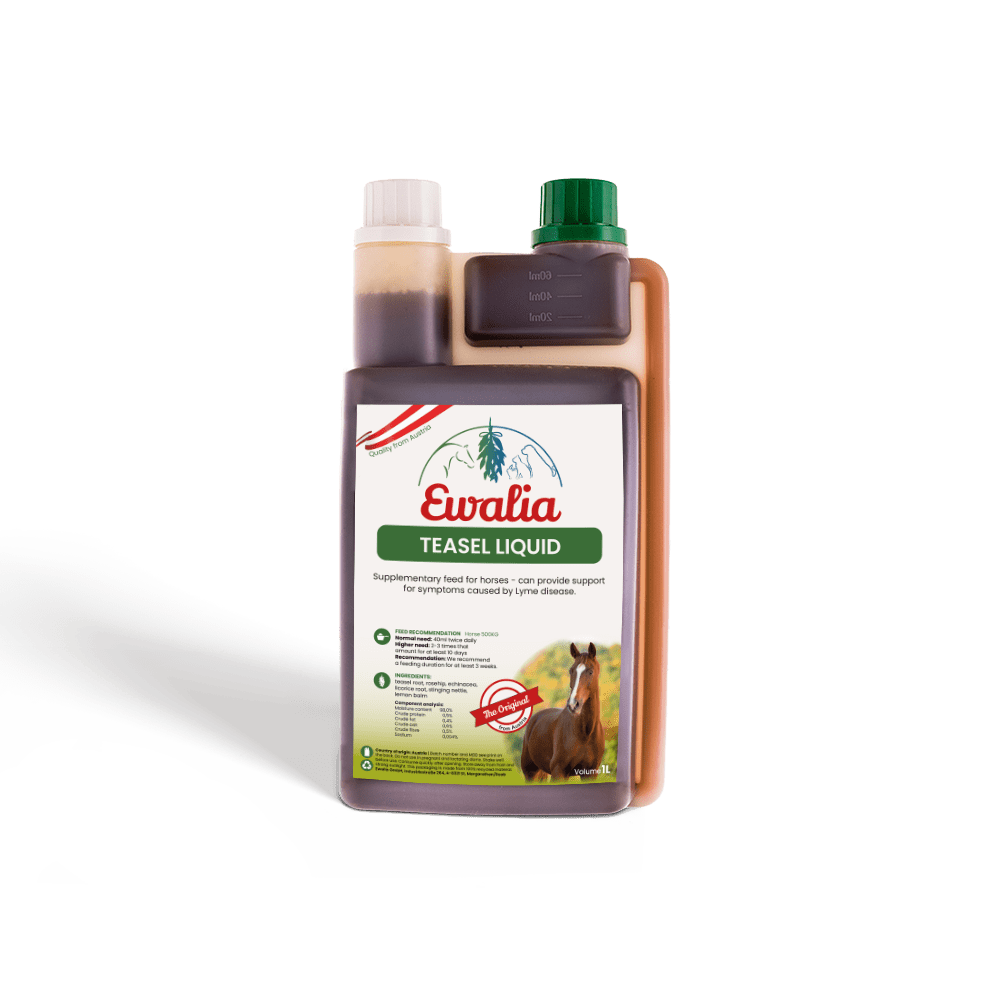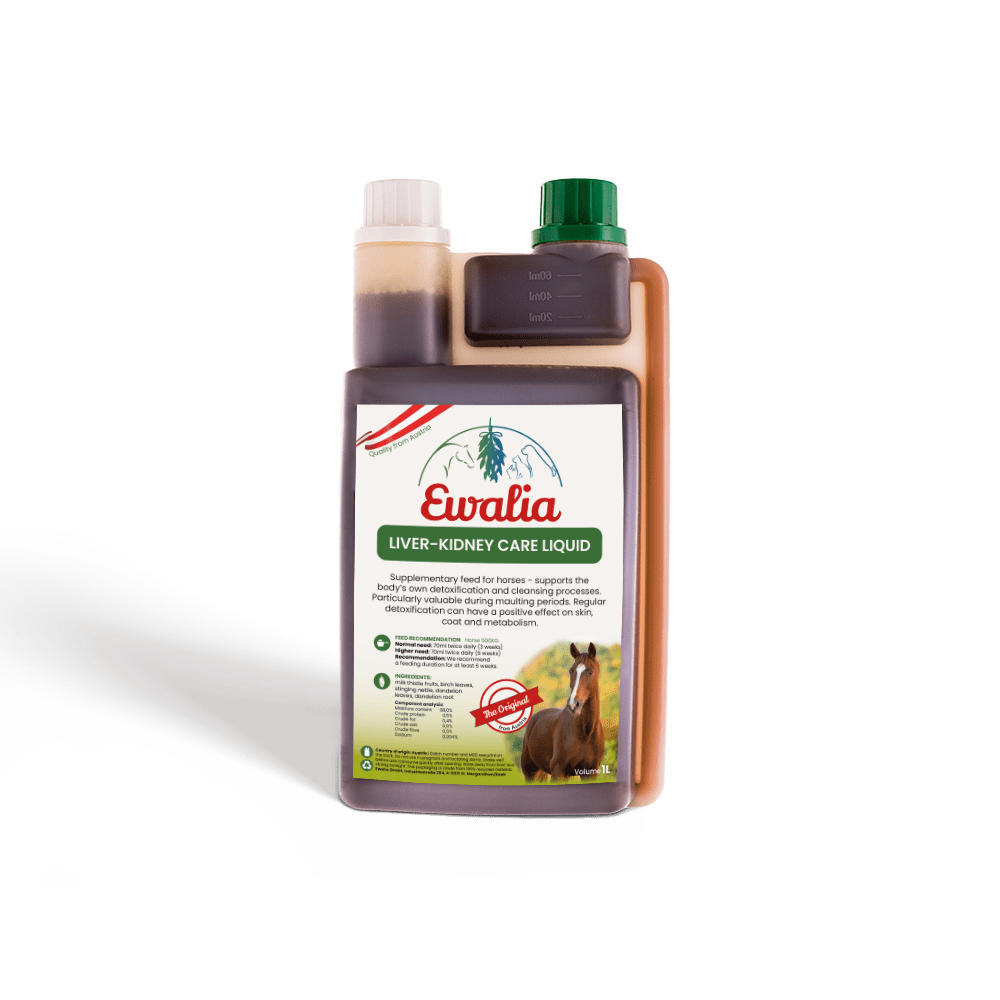Lyme disease in horses

In horses, Lyme disease (Lyme borreliosis) can cause a wide variety of symptoms and treatment often proves ineffective. In this article we discuss the signs of Lyme borreliosis, how you can protect your horse from the disease and which herbs offer support.
What is Lyme disease?
Lyme borreliosis, commonly called Lyme disease, is a non-contagious infectious disease that is transmitted through the bites of certain ticks. Scientifically speaking, it is often called a tick bite because the tick first cuts the skin with its jaw claws and then pushes the hypostome into the wound and anchors itself there. Before it starts sucking blood, the tick secretes saliva on the wound. This allows Borrelia bacteria to be transmitted and spread through the lymphatic vessels in the host’s body. Borrelia bacteria cause a wide range of symptoms that can strongly affect the horse. They are difficult to detect, which means that they are frequently not detected until advanced stages.
Although its puzzling symptoms have been described in historical medical studies, the disease was only recently recognised. In the late 1970s, human medicine became aware of increased occurrences of joint inflammation in the American town of Old Lyme, Connecticut. The disease, with its wide range of symptoms, became known as “Lyme disease”. The cause was determined to be an infection by a previously unknown species of Borrelia found in the intestines of ticks. The pathogen was named Borrelia burgdorferi, after the scientist who discovered it. Soon after, Lyme disease also attracted attention in veterinary medicine. In 1984 Borrelia were first detected in the blood of a dog showing signs of fever and lameness. The first case description of equine Lyme disease dates back to 1986.
Equine borreliosis: a controversial diagnosis
There is ongoing discussion in veterinary medicine as to whether Borrelia infections in horses lead to disease. It has not been fully explained to date which equine ailments are triggered by Borrelia infections and how exactly the disease progresses. The range of clinical symptoms make it hardly possible to give a definite diagnosis.
Characteristic symptoms include general condition disturbances, muscle and joint ailments, and diseases of the nervous system and/or cardiovascular system. There are three types of Borrelia found in our latitudes. A diagnosis of infection is difficult, as the affected animal may lack typical signs like the circular rash (Erythema chronicum migrans) and present symptoms that are also symptoms of other diseases. Borreliosis, then, often remains undetected.
Is Lyme disease common in horses?
Almost every horse, in the course of its life, will encounter ticks. According to the Robert Koch Institute, between 5 and 35 percent of the ticks in Germany are infected with Borreliosis. These pesky bloodsuckers are active at temperatures above 7 °C and infect horses at pasture, on country hacks, and even in the barn. But not every horse bitten by an infected tick will contract borreliosis. A strong immune system can keep an infection under control. Blood tests from clinically healthy horses in Europe and the USA have shown that 60% of horses have antibodies against Borrelia bacteria. This means that they have come into contact with Borrelia without falling ill from borreliosis.
What are Borrelia and how are they transmitted?
Borrelia are spiral-shaped bacilliform bacteria that live in the intestines of ticks. Ticks can be infected in every development stage (larva, nymph, adult) and become carriers. The adult tick becomes infected by sucking the blood of infected wild animals such as mice or deer. As the tick bites other animals, the Borrelia bacteria become active due to the increase in the tick's body temperature, migrating into its salivary glands. Transmission occurs after about one day of attachment to the host animal.
Borreliosis is found everywhere that ticks live. In Europe, the main carriers are hard ticks of the genus Ixodes ricinus (castor bean ticks), hedgehog ticks, and dog ticks. The risk of infection increases in summer and early autumn, when ticks are at their most active. But even in winter, the danger remains: when temperatures are mild, active ticks can be brought into barns with wild animals.
What happens in a Borrelia infection?
Starting at the bite site, the bacteria spread via the lymphatic system. At first they reproduce slowly, allowing them to "outsmart" the horse's immune system, which is often slow to react to low-grade infestations, and spread unhindered. Borrelia bacteria’s rotating movements also allow them to penetrate poorly perfused tissue, such as tendons and cartilage, where they survive in a "dormant" or persistent form and are not reached by antibiotics. They prefer to settle in the collagen fibres of the heart and nerve tissue as well as in the horse’s joints. The pathogens reproduce by division, and only at this stage are they sensitive to antibiotics. This explains why there are many relapses during Lyme disease therapy and why treatment can take a long time.
What is the course of equine Lyme disease?
The incubation period from tick bite to the appearance of the first symptoms can range from a few days to several weeks. A local inflammation occurs at the bite site, which usually goes unnoticed under the horse's coat. Any restlessness and itching are frequently attributed to other insects that usually plague horses in warm weather. Other signs of an incipient Borrelia infection – fatigue, mild fever, lack of appetite – are easily overlooked. When the bacteria begin to spread in the horse's body, vague disturbances occur in its general condition, including fever, weakness, skin changes, eye inflammations, and colic-like complaints. The wide range of possible symptoms is the reason why borreliosis is so rarely noticed. If the underlying disease remains untreated, the bacteria are able to settle in the horse’s organism and cause exacerbations. The borreliosis becomes chronic.
Which symptoms point to borreliosis?
The following symptoms can occur, depending on the stage and severity of the disease:
- Stiffness and stiff gait
- Tight muscles
- Vague, often shifting lameness
- Painful swelling of one or more joints in the extremities
- Oedemas
- Skin changes including eczema, skin fungi, dull coat, hair loss
- Painful, sensitive skin
- Hoof problems such as abscesses
- Laminitis
- Loss of appetite and weight loss
- Increased susceptibility to infection, recurrent fever or coughing
- Increased disposition to allergies
- Organic heart, kidney, or liver disease
- Colic
- Bilateral eye diseases
- Central nervous system disorders
- Headshaking
- Behavioural issues like sudden nervousness or aggression
Most afflicted horses are not seen by the vet until the infection has caused clear symptoms. Undiagnosed borreliosis is first treated symptomatically. This means that, if the horse suffers from lameness, it is the lameness that is treated, etc. As exacerbations mostly appear in waves and the horse appears completely healthy in between episodes, this gives the impression that treatment was successful – until the next episode.
How is Lyme borreliosis diagnosed?
The diagnosis of a Borrelia infection is done through a blood test. Any information that you can provide your vet on your horse’s state of health is also important.
Risk factors
The first question is whether the horse lives in a tick-infested area and was bitten by a tick. If your horse spends most of its time turned out or if you like to go out on country hacks, there is a very high likelihood that your horse has come into contact with ticks. It is possible that there have already been cases of Lyme disease in other horses in or around the yard.
Symptoms
After the clinical examination, it is important for the vet to know whether you have noticed changes to your horse’s health in connection with a tick bite. Maybe you interpreted the first symptoms as unwillingness, your horse having a bad day, lethargy from the summer heat, etc. Or your horse has borreliosis symptoms that you did not consider important, because they always improved.
Laboratory analysis
If borreliosis is suspected, a blood test can be sent to a laboratory for analysis. Antibody titres present will indicate that the horse's immune system has reacted to Borrelia. However, it is not possible to determine whether the infection is recent or from some point in the past. And an infection is not always possible to prove. Because of the immune system’s slow reaction time to Borrelia, some horses develop antibodies late, or not at all. The presence of antibiotics can also lead to false results. In any case, the blood test for antibodies should be repeated several times to mark any changes. One reliable method for determining a fresh infection is through the Western blot test. In this laboratory procedure, proteins are transferred to a carrier medium to detect antibodies in serum.
A very reliable proof of a Borrelia infection is the detection of living Borrelia on a tissue culture. To obtain a tissue culture, the bacteria are cultivated from tissue samples taken through a skin biopsy or puncture of the joint. Because Borrelia reproduces very slowly, it can take up to three weeks for a result. A PCR test can be used to detect Borrelia DNA in a tick. This test is only used rarely, as the transmitting tick is rarely found to still be on the horse.
Are there special tests for borreliosis?
For several years there have been specific borreliosis tests on the market; these are designed to detect Lyme disease at any stage based on a single blood test by measuring the horse's immune response. The tests are expensive and the results are not undisputed, as there are no reference values for the horse's immune response.
How is borreliosis treated?
For treating Lyme disease, veterinary treatment with high doses of antibiotics is essential. Since the Borrelia bacteria are not reached by the medication when they are dormant, treatment must be carried out over several weeks to eliminate all pathogens.
Nevertheless, it can be that some Borrelia remain in the body and trigger episodes at a later time, in which case treatment must be repeated. Further antibody tests are recommended as a control.
Prolonged administration of antibiotics can lead to severe side effects in horses, as they not only kill illness-causing bacteria, but also beneficial gut bacteria resulting in digestive problems and the increased risk of metabolic disorders. Possible side effects from treatment should therefore be prevented with natural means, such as herbs that promote intestinal health.
There are several herbs that help to stabilise a horse’s gut flora. Marsh-mallow contains mucilaginous substances that protect the intestinal epithelium. Peppermint soothes irritated bowels. The bitter substances in yarrow stimulate the formation of intestinal juices. Raspberry leaves and oak bark are rich in tannins, which support the natural barrier function of the intestinal epithelium. The intestinal flora can also be re-established with special bacteria cultures. In addition, a bland diet is called for.
After completion of treatment, herbs can promote the body's own detoxification processes, stimulate liver and kidney activity, and boost the metabolism. Milk thistle is known to have positive effects on the liver, supporting its function and helping regeneration. Birch leaves, nettle, and dandelion promote kidney function and help to flush out harmful substances.
Does wild teasel help in treating borreliosis?
Wild teasel is often used as an effective healing plant in the treatment of borreliosis. The effect of teasel against Lyme disease-related complaints has not been scientifically proven, but is based on empirical values. In cases of borreliosis, wild teasel can be fed as supportive therapy following treatment with antibiotics to promote regeneration of the organism and stave off any long-term effects. For horses in which antibiotic treatment is not successful, wild teasel can represent an alternative that helps them feel better. A decision about an alternative therapy should always be made in consultation with your vet.
How can I keep my horse from Borrelia infection?
The most important thing you can do is to protect your horse from tick bites. This recommendation, however, is hardly feasible, because there are ticks all around us. If your horse is one of those animals that are magnets for ticks, you can use repellents during tick season. When using repellents, pay attention to your animal’s tolerance of them.
During daily grooming, check your horse carefully for ticks. Ticks prefer thinly haired parts of the body, such as the head, neck, legs, and skin folds. Borrelia bacteria need between 8 and 24 hours to move from the tick, so the earlier you find and remove the tick, the better.
Tip: Never oil or squeeze the tick to remove it! A tick fighting against suffocation will release large quantities of saliva. It is better to remove the tick in one go!
Boosting immune system with herbs
Early in the tick season, your horse’s immune system is under considerable strain, for example from moulting, transition to pasture, or stress from increased training demands. A natural immune booster will help your horse cope with increased stress.
Herbs like echinacea, vitamin-packed rose hips, and strengthening yellow gentian bring the immune system back into swing. A strong immune system can keep Borrelia bacteria in check and prevent an outbreak of the disease.
Is there a vaccine for Lyme disease?
For some years now, there has been a Lyme disease vaccine on the market that prevents the migration of Borrelia bacteria from the tick. This vaccine is especially recommended for horses that live turned out 24/7 in tick areas or are worked mainly outdoors. The first vaccination is possible for foals from three months of age. Ideally, the horse should be vaccinated before the start of the tick season, as the antibodies need will need two to three weeks to build up after basic immunisation. Vaccination should first be done semi-annually, then repeated annually.
Caution: Do not vaccinate a horse that has (or is suspected to have) Lyme disease! In case of doubt, test the horse before vaccination!
Sources
- Caroline Fritz: Retrospektive Betrachtung serologischer Ergebnisse verschiedener Borrelien-Antikörper-Nachweisverfahren unter dem Aspekt einer möglichen Kategorisierung klinischer Befunde bei Equiden, Dissertation, München 2018 ( https://edoc.ub.uni-muenchen.de/21955/1/Fritz_Caroline.pdf
- https://www.atm.de/blog/redaktionelles/borreliose-beim-pferd
- https://parasitenportal.de/parasiten-beim-pferd/
- https://www.tiergesund.de/krankheiten/pferd/borreliose
- https://laboklin.com/at/products/infectious-diseases-pathogenic-agents-and-antibody-detection/bacteria/borrelia/
- https://vet-magazin.de/firmennews-deutschland/industrie-grosshandel/boulder-diagnostics/Borreliose-Test-Pferde-Hunde.html

















